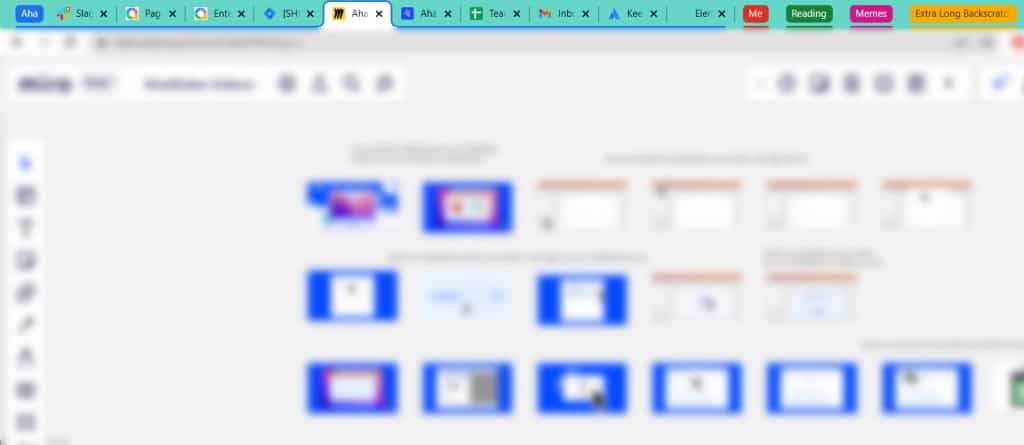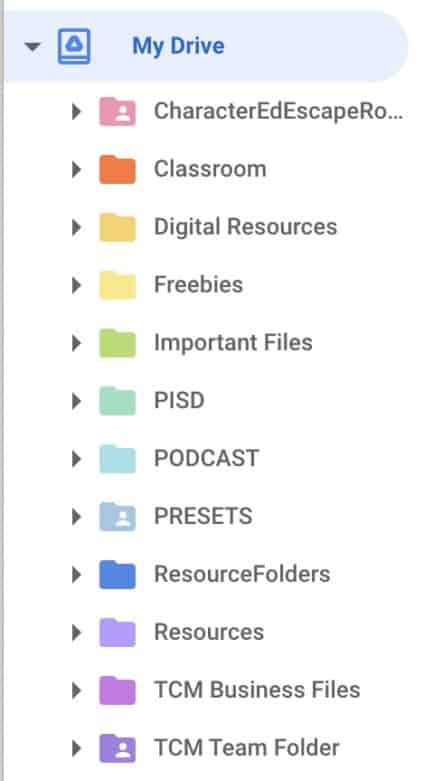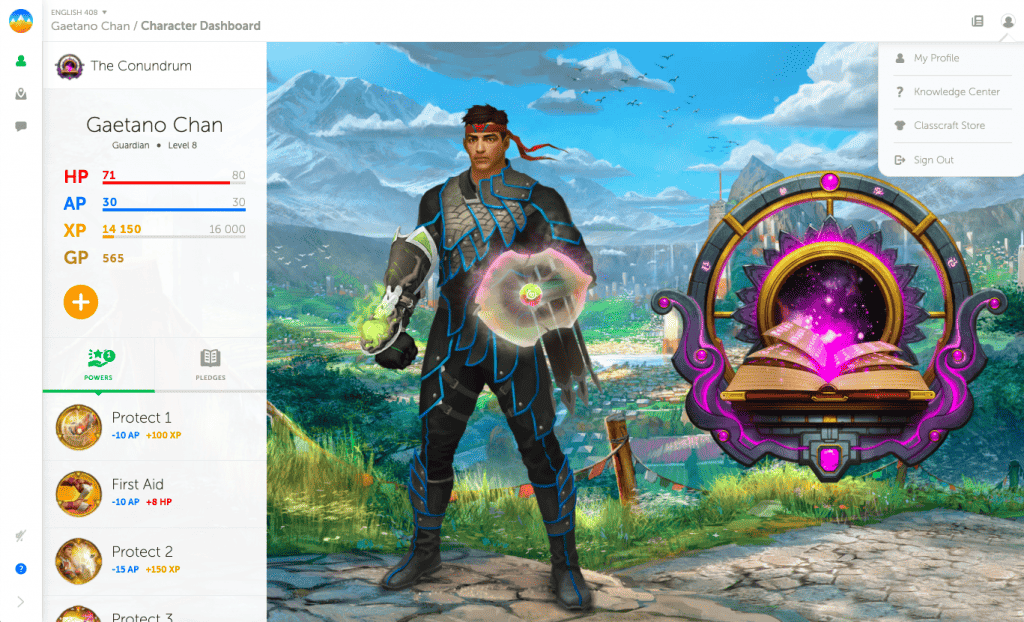Dit is één van de dingen die ze je niet op school leren:
Volwassen zijn met een volwassen baan vereist een onheilige hoeveelheid organisatie.
En kijk nu eens naar jou, een volwassene met de organisatievaardigheden van een vijfjarige. Maak je geen zorgen – zo voelen we ons allemaal.
Als je dingen georganiseerd en gemakkelijk toegankelijk hebt, kan dit je niet alleen aanzienlijk minder faff opleveren, het kan je op de lange termijn ook uren van je kostbare tijd besparen.
Bijkomend voordeel - het stopt je spartelend als een panische haring wanneer je iets moet vinden voor 30 stille studenten.
Hier zijn 8 toptips om je online onderwijs te organiseren.
Uw werkruimte
Voordat u uw digitale baan kunt organiseren, moet u uw fysieke leven organiseren.
Ik bedoel niet dat je grote, ingrijpende veranderingen in je relaties en gezondheid moet doorvoeren... Ik bedoel alleen dat je wat spullen op je bureau moet verplaatsen.
Er was waarschijnlijk een tijd, voordat je de overstap online maakte, dat je ervan uitging dat je online leerwerkplek er zo uit zou zien 👇

Ha! Stel je voor...
Laten we eerlijk zijn: je bureau ziet er helemaal anders uit. Ook al zag het er aan het begin van het schooljaar zo uit, nu kijk je naar een hel van gekreukt papier, gebruikte pennen, koekkruimels en 8 kapotte koptelefoons waarvan je beloofd had ze te laten repareren.
We dromen allemaal van een perfect ingericht bureau, maar vooral bij het lesgeven is het precies het tegenovergestelde zo goed als onvermijdelijk.
Het is hoe je transactie met de rommel die ervoor kan zorgen dat je lessen niet in een roes verdwijnen.
#1 – Segmenteer uw ruimte
Dat klinkt misschien voor de hand liggend, maar al je spullen slingeren rond op je bureau omdat het dakloos is.
Het heeft geen plaats om het zijn eigen te noemen, daarom ligt het op een zo onhandig mogelijke manier met andere objecten rond.
Segmenteer uw bureau in verschillende gebieden voor papier, schrijfwaren, boeken, speelgoed en persoonlijke bezittingen en bewaar ze vervolgens uitsluitend binnen dat gebied kan een grote stap zijn naar een opgeruimd bureau.
Hier zijn enkele dingen die u nu kunt kopen om de segmentatie te helpen.
- Een papierlade – Een eenvoudige set (bij voorkeur transparant) onderbroek waar u uw verschillende papier kunt rangschikken onder categorieën zoals aantekeningen, pakketten, markeren, enz. Krijg gekleurde mappen en tabbladen om die categorieën voor elk van uw klassen te scheiden.
- Knutseldoos – Een grote doos (of een set dozen) waarin je je knutselspullen kunt doen. Knutselen is een rommeltje, dus maak je niet al te druk over het netjes opbergen van je spullen in de doos.
- Een pennenhouder - Een eenvoudige mand om je pennen in te bewaren. Ben je net als ik een fervent verzamelaar van whiteboardmarkers? Probeer dan dit: wees dat niet. Geen mitsen en maren; als een pen op is (of het leven begeeft), gooi hem dan weg...
- ...een bak – Hier hoort afval thuis. Moest ik je dat nou echt vertellen?
#2 – Verander het overdag
Als u voor de dag uitklokt, ruimt u dan uw bureau op of gooit u gewoon uw handen in de lucht en springt u ter viering in bad?
Niemand zegt dat je de tweede optie niet moet doen, maar misschien kun je de festiviteiten met 5 minuten uitstellen en eerst, verwijder de rommel van de dag van je bureau.
Het grootste deel van wat u vandaag hebt gebruikt, hebt u morgen niet meer nodig als u aan uw bureau gaat zitten. Als u uw bureau opruimt, houdt u dus een tabula rasa; een onbeschreven blad waarmee je kunt zetten Slechts wat je voor de dag nodig hebt qua materialen.
Op deze manier staat al die rommel ofwel ergens anders in je thuiskantoor, ofwel in de prullenbak. Hoe dan ook, het staat niet op je bureau, dus de kans dat het zich opstapelt en uitgroeit tot iets monsterlijks is aanzienlijk kleiner.

#3 – Als het niet kapot is, repareer het dan niet
Een rommelig bureau is een teken van een rommelige geest, zeggen ze, behalve dat noch een rommelig bureau, noch een rommelige geest altijd een slechte zaak is.
Rommelige geesten do hebben de neiging om rommelige bureaus te creëren, maar volgens een studie gepubliceerd in Psychological Science, zijn gewoon creatiever in het algemeen.
Uit het onderzoek bleek dat een rommelig bureau iemand vol nieuwe ideeën kan vertegenwoordigen en iemand die meer bereid is creatieve risico's te nemen.
"Ordelijke omgevingen daarentegen moedigen conventie aan en spelen op veilig", legt leider van het onderzoek, Kathleen Vohs, uit.
Dus het komt er eigenlijk allemaal op neer wat voor persoon je bent. Als je jezelf een creatieve ziel vindt, trek je dan niets aan van wat de anti-rommel-syndicaten zeggen; laat de chaos over je bureau verspreid liggen en geniet van de dagelijkse creativiteitsboost die het je geeft.
Uw bronnen
Natuurlijk is er nu minder papierwerk nu je online lesgeeft, maar de bergen aan digitale rommel dat je er als het ware onder bedolven wordt is niet veel beter.
Het gemiddelde semester ziet mogelijk meer dan 1000 tabbladen geopend, 200 chaotische Google Drive-mappen en 30 vergeten wachtwoorden. Dat niveau van wanorde kan gênante onderbrekingen in de lessen veroorzaken.
Probeer op de hoogte te blijven van al deze digitale documenten. Het lijkt nu misschien onmogelijk, maar kleine veranderingen in de manier waarop u uw organisatie organiseert, kunnen u later grote kopzorgen besparen.
#4 – Groepeer uw tabbladen
We hebben allemaal gehoord dat een rommelige browser net zo erg is als een rommelig bureau. Maar nogmaals, dat is gewoon niet waar.
Misschien bent u al een van die mensen met 42 open tabbladen, zonder enige organisatie en een complete wirwar van tabbladen voor werk, tabbladen voor jij tijd en tabbladen om te leren hoe u uw aantal tabbladen kunt verminderen.
Welnu, allereerst zegt Malcolm Gladwell, auteur van zaken en filosofie, dat je je geen zorgen hoeft te maken over de... hoeveelheid van uw 42 tabbladen. Hel, zegt hij"ga naar vijftig". Als de tabbladen interessant en relevant zijn voor wat je doet, is er geen reden om ze te beperken.
De organisatie Een van die tabbladen kan een probleem vormen. Het is nooit goed om voor een klas vol zwijgende studenten door de bovenste balk van je browser te moeten klauteren, zwetend en biddend dat je niet per ongeluk die Amazon-bon opent voor een extra lange ruggenkrabber waarvan je WEET dat die hier ergens ligt...
Hiervoor is een eenvoudige oplossing…

Die gekleurde tabbladen bovenaan mijn browser helpen me om mijn werk te scheiden van mijn tijd, leestijd, meme-tijd en de tijd die ik besteed aan het onderzoeken van zeldzame en waardevolle extra lange backscratchers.
Ik doe dit in Chrome, maar het is ook een functie van andere browsers zoals Vivaldi en Brave. Het is nog geen functie in Firefox, maar er zijn genoeg extensies die dit daar kunnen, zoals Werkona en Boomstijl Tab.
Je kunt gewoon het tabblad uitvouwen dat je nodig hebt voor die les, terwijl je al het andere samenvouwt.
#5 – Houd je Google Drive netjes
Een andere hoop rommel die je zou kunnen vinden, bevindt zich waarschijnlijk in je Google Drive.
Als u net als 90% van de andere docenten bent, stelt u het organiseren van uw Google Drive vast uit totdat u expliciet te horen krijgt dat u bijna geen ruimte meer heeft.
Het is vaak een ontmoedigende taak om Google Drive te organiseren, alleen al vanwege de enorme hoeveelheid spul daar. Als je die dingen ook met andere leraren deelt en allen van je leerlingen, lijkt het misschien een onmogelijke berg.
Dus probeer dit: in plaats van op te ruimen wat je al hebt, begin gewoon vanaf nuNegeer wat er al is en organiseer nieuwe documenten in mappen.

Kleurgecodeerde dingen zoals deze zien er niet alleen geweldig uit, het helpt zowel de organisatie als motivatie organiseren, dat is de sleutel. Het duurt niet lang of u voelt zich natuurlijk gedwongen om al uw bestaande werk naar deze mooie kleine mappen te verplaatsen.
Geen zin in kleurcodering? Helemaal prima. Er zijn nog veel meer dingen die je kunt doen om je Google Drive georganiseerd te houden:
- Mapbeschrijvingen toevoegen – Je kunt een beschrijving toevoegen aan elke map met een vage titel of een titel die lijkt op een andere map. Bekijk de beschrijving door met de rechtermuisknop op de map te klikken en 'Details' te selecteren.
- Nummer je mappen – De belangrijkste mappen staan mogelijk niet alfabetisch bovenaan, dus plaats een nummer voor de naam, afhankelijk van de prioriteit. Documenten voor examens zijn bijvoorbeeld vrij belangrijk, dus zet er een '1' voor. Zo worden ze altijd bovenaan in een lijst weergegeven.
- Negeer 'gedeeld met mij' – De map 'gedeeld met mij' is een ware woestenij van vergeten documenten. Het opruimen ervan duurt niet alleen een eeuwigheid, het is ook nog eens funest voor je collega-docenten, omdat die documenten gemeenschappelijk zijn. Doe jezelf een plezier en negeer de hele map gewoon.
#6 – Wees slim met uw wachtwoorden
Ik wed dat je ooit dacht dat je al je wachtwoorden wel zou onthouden. Je hebt je waarschijnlijk aangemeld bij een paar online diensten en dacht dat het onthouden van de inloggegevens een fluitje van een cent zou zijn.
Nou, dat was waarschijnlijk lang geleden, in het stenen tijdperk van het internet. Nu, met online lesgeven, heb je... tussen 70 en 100 wachtwoorden en beter weten dan ze volledig op te schrijven.
Wachtwoordmanagers lossen dit goed op. Natuurlijk heb je een wachtwoord nodig om er toegang toe te krijgen, maar het behoudt alle wachtwoorden die je gebruikt voor alle tools in je school- en privéleven.
Houder is een goede, veilige optie, zoals het is Noordelijke pas.
Natuurlijk bieden de meeste browsers tegenwoordig ook een 'voorgesteld wachtwoord' aan dat ze voor je opslaan wanneer je je aanmeldt voor iets nieuws. Maak hier zo vaak mogelijk gebruik van.
Uw communicatie
Online lesgeven is een beetje een zwart gat voor communicatie.
Studenten praten minder, zowel met jou als met elkaar, en toch is het nog steeds moeilijker om bij te houden wie wat op welk moment heeft gezegd.
Er zijn verschillende hulpmiddelen om u te helpen het gesprek van uw klas te volgen, ernaar terug te bellen als dat nodig is en berichten achter te laten die bij uw leerlingen blijven.
#7 – Gebruik een berichten-app
En toch dringen velen er nog steeds op aan dat leraren het gebruiken om in contact te blijven met elkaar, met ouders en met leerlingen.
De realiteit is dat e-mailcommunicatie is traag, gemakkelijk te missen en zelfs gemakkelijker om volledig uit het oog te verliezen. Je leerlingen maken deel uit van een generatie waar communicatie precies het tegenovergestelde is van al die dingen, dus hen dwingen om het te gebruiken is als jouw leraar vroeger die je dwong te praten via rooksignalen en komisch grote mobiele telefoons.
Met een instant messaging-app heb je eenvoudig toegang tot al je correspondentie met studenten, hun ouders en je eigen sportschool.
Slack en Classificatie werken hier prima voor, omdat ze allebei eenvoudige zoekfuncties hebben en de mogelijkheid hebben om een heleboel verschillende kanalen op te zetten waar je je kunt concentreren op klasprojecten, buitenschoolse groepen en gewoon om over het weer te kletsen.
#8 – Gebruik een hulpmiddel voor klassenbeheer
Het idee om sterren uit te delen voor goed gedrag en ze af te pakken voor slecht gedrag, is ongeveer net zo oud als de school zelf. Het is een klassieke manier om jongere leerlingen betrokken te houden bij het leren.
Het probleem is dat, in het online klaslokaal, transparant Het is lastig om je sterrentoewijzing bij te houden. Het bord is niet voor iedereen direct zichtbaar, en het gevoel dat het er echt toe doet, kan gemakkelijk verloren gaan. Uiteindelijk wordt het lastig om het aantal sterren van elke student gedurende het semester bij te houden.
Een online hulpmiddel voor klassenbeheer is niet alleen zichtbaarder en beter te volgen, maar ook aanzienlijk motiverender voor studenten dan een eindeloze reeks sterren.
Een van de beste in de buurt is Klassikaal, waarin je leerlingen hun eigen karakters maken en deze naar een hoger niveau tillen door taken te voltooien die je hen toewijst.
Alles wordt voor u bijgehouden, zodat u niet door stapels foto's op uw telefoon hoeft te spitten om te proberen ieders sterren te tellen.

Andere snelle tips
Dat is nog niet alles! Er zijn talloze kleine gewoontes die je kunt aanleren voor een betere organisatie waar het ertoe doet...
- Schrijf je schema op – Een dag zomaar voelt zich beter georganiseerd als het op papier staat. Schrijf de avond ervoor je volledige lesrooster voor de volgende dag uit en geniet vervolgens van het afvinken van elke les, vergadering en andere mijlpaal tot het tijd is voor een wijntje!
- Ga op Pinterest – Als je net als ik een beetje laat bent met Pinterest, bedenk dan dat je beter laat dan nooit kunt zijn. Er zijn ongelooflijk veel lesmaterialen en inspiratiebronnen die je helpen je planning op één plek te organiseren.
- YouTube-afspeellijsten maken – Sla niet alleen de links op – maar zet al dat videomateriaal in een afspeellijst op YouTube! Zo is het makkelijker om alles bij te houden en kunnen leerlingen alle video's in de lijst bekijken.
Nu u volledig bent ondergedompeld in virtueel lesgeven, vindt u de online wereld waarschijnlijk een stuk rommeliger dan u in eerste instantie dacht.
Gebruik deze tips om je dagelijkse chaos op te lossen, je lessen te organiseren en uiteindelijk kostbare weekuren te sparen die je kunt gebruiken voor helpen tijd.
Als je eenmaal je dagelijkse chaos hebt georganiseerd, verdien je die tijd om te ontspannen.








